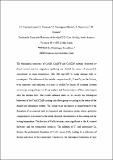Por favor, use este identificador para citar o enlazar a este item:
http://hdl.handle.net/10261/101940COMPARTIR / EXPORTAR:
 SHARE SHARE
 CORE
BASE CORE
BASE
|
|
| Visualizar otros formatos: MARC | Dublin Core | RDF | ORE | MODS | METS | DIDL | DATACITE | |

| Campo DC | Valor | Lengua/Idioma |
|---|---|---|
| dc.contributor.author | Sánchez-López, J.C. | - |
| dc.contributor.author | Contreras, A. | - |
| dc.contributor.author | Domínguez-Meister, Santiago | - |
| dc.contributor.author | García-Luis, Alberto | - |
| dc.contributor.author | Brizuela, Marta | - |
| dc.date.accessioned | 2014-09-10T10:19:34Z | - |
| dc.date.available | 2014-09-10T10:19:34Z | - |
| dc.date.issued | 2014 | - |
| dc.identifier | doi: 10.1016/j.tsf.2013.10.041 | - |
| dc.identifier | issn: 0040-6090 | - |
| dc.identifier.citation | Thin Solid Films 550: 413- 420 (2014) | - |
| dc.identifier.uri | http://hdl.handle.net/10261/101940 | - |
| dc.description.abstract | The tribological properties of CrAlN, CrAlYN and CrAlZrN coatings deposited by direct current reactive magnetron sputtering are studied by means of pin-on-disc experiments at room temperature, 300, 500 and 650 C using alumina balls as counterparts. The influence of the metallic composition (Al, Y and Zr) on the friction, wear properties and oxidation resistance is studied by means of scanning electron microscopy, energy dispersive X-ray analysis and Raman analysis of the contact region after the friction tests. The results obtained allow us to classify the tribological behaviour of the CrAl(Y,Zr)N coatings into three groups according to the nature of the dopant and aluminium content. The sliding wear mechanism is characterized by the formation of an overcoat rich in chromium and aluminium oxides whose particular composition is determined by the initial chemical characteristics of the coating and the testing temperature. The fraction of Cr2O3 becomes more significant as the Al content decreases and the temperature increases. The addition of Y, and particularly Zr, favours the preferential formation of Cr2O 3 versus CrO2 leading to a reduction of friction and wear of the counterpart. Conversely, the tribological behaviour of pure CrAlN coatings is characterized by higher friction but lower film wear rates as a result of higher hardness and major presence of aluminium oxides on the coating surface. © 2013 Elsevier B.V. | - |
| dc.publisher | Elsevier | - |
| dc.rights | openAccess | - |
| dc.subject | Raman | - |
| dc.subject | Tribolayer | - |
| dc.subject | Wear | - |
| dc.subject | Oxidation | - |
| dc.subject | Friction | - |
| dc.subject | Magnetron sputtering | - |
| dc.subject | CrAlN | - |
| dc.subject | Yttrium | - |
| dc.title | Tribological behaviour at high temperature of hard CrAlN coatings doped with y or Zr | - |
| dc.type | artículo | - |
| dc.identifier.doi | 10.1016/j.tsf.2013.10.041 | - |
| dc.date.updated | 2014-09-10T10:19:35Z | - |
| dc.description.version | Peer Reviewed | - |
| dc.language.rfc3066 | eng | - |
| dc.type.coar | http://purl.org/coar/resource_type/c_6501 | es_ES |
| item.cerifentitytype | Publications | - |
| item.openairecristype | http://purl.org/coar/resource_type/c_18cf | - |
| item.grantfulltext | open | - |
| item.openairetype | artículo | - |
| item.fulltext | With Fulltext | - |
| Aparece en las colecciones: | (ICMS) Artículos | |
Ficheros en este ítem:
| Fichero | Descripción | Tamaño | Formato | |
|---|---|---|---|---|
| Paper Tribo-Q JC Sanchez-Lopez Digital CSIC.pdf | 591,44 kB | Adobe PDF |  Visualizar/Abrir |
CORE Recommender
SCOPUSTM
Citations
58
checked on 24-abr-2024
WEB OF SCIENCETM
Citations
53
checked on 21-feb-2024
Page view(s)
330
checked on 05-may-2024
Download(s)
512
checked on 05-may-2024
Google ScholarTM
Check
Altmetric
Altmetric
NOTA: Los ítems de Digital.CSIC están protegidos por copyright, con todos los derechos reservados, a menos que se indique lo contrario.
